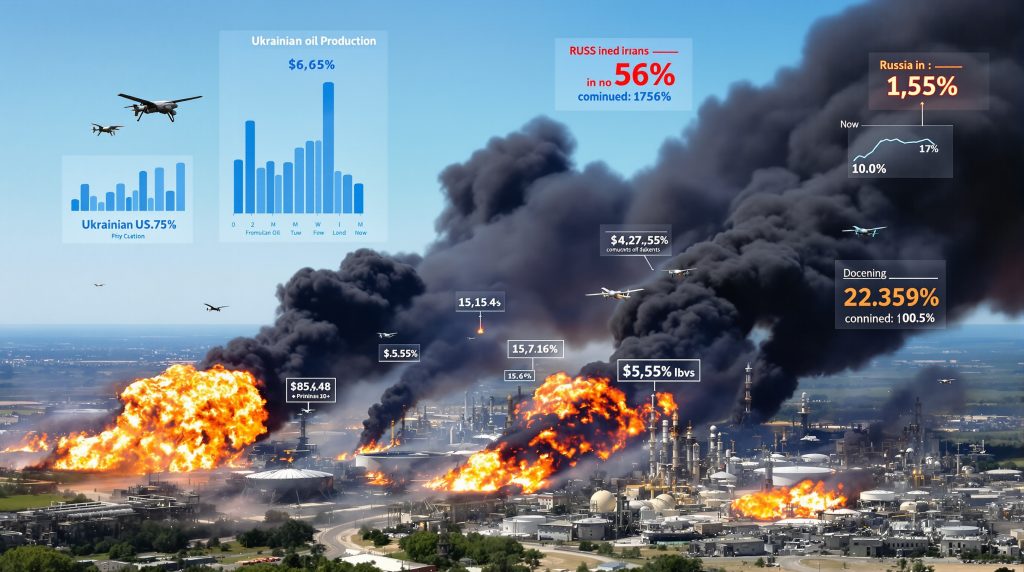How Ukrainian Drone Attacks Target Russia's Energy Sector
Ukrainian forces have executed a systematic campaign against Russian oil infrastructure, employing precision drone strikes to disrupt Russia's energy production capabilities. These attacks have targeted refineries, storage facilities, and export terminals across Russian territory, representing a significant evolution in Ukraine's military strategy. Rather than solely engaging Russian forces on the battlefield, Ukraine has expanded operations to undermine Russia's economic foundations and war-making capacity.
The strikes employ a variety of unmanned aerial vehicles (UAVs), from modified commercial drones to more sophisticated military models, demonstrating Ukraine's growing technological capabilities in asymmetric warfare. These operations have proven remarkably effective at penetrating Russian air defenses and striking critical infrastructure hundreds of kilometers from Ukrainian territory.
According to energy security expert Cyril Widdershoven, Ukrainian forces have executed "precision strikes and drone attacks on Russian oil refineries, fuel depots, and related logistics" representing "strategic success" in targeting "the Kremlin's economic lifelines" (Source: Widdershoven, C. "Forget OPEC Warnings The Real Oil Shock Is Happening Inside Russia," Oilprice.com, September 2023).
Beyond aerial drones, Ukraine employs "maritime drones and missiles" in its infrastructure attacks campaign, significantly expanding its strike capabilities and complicating Russian defensive efforts. These attacks have had a significant OPEC production impact on global energy markets.
What Russian Oil Facilities Have Been Hit by Ukrainian Drones?
Major Refineries Under Attack
Ukrainian drone strikes have successfully targeted numerous high-value oil processing facilities across Russia, including:
-
Rosneft's Tuapse Refinery: Located on the Black Sea coast, this facility processes approximately 240,000 barrels per day (bpd) and serves as a critical export hub. Drone attacks caused significant fire damage to distillation units.
-
Lukoil's Volgograd Refinery: This inland facility with 290,000 bpd capacity suffered multiple strikes, damaging crude processing units and forcing partial shutdowns.
-
Gazprom's Omsk Refinery: One of Russia's largest facilities at 420,000 bpd capacity experienced targeted attacks on its catalytic cracking units, reducing gasoline production capabilities.
-
Salavat Petrochemical Complex: Located in Bashkortostan, this major refining and petrochemical facility produces gasoline, diesel, and petrochemical products. Recent strikes triggered extensive fires requiring emergency response operations.
-
Afipsky Oil Refinery: This strategic facility in Krasnodar Krai, representing approximately 2.1% of Russia's refining capacity, has been hit repeatedly. The facility supplies diesel and aviation kerosene to Russian military forces.
Oil Storage and Export Infrastructure
Beyond refineries, Ukrainian forces have targeted:
-
Novorossiysk Oil Terminal: A critical Black Sea export facility handling millions of barrels monthly has faced multiple drone attacks disrupting loading operations.
-
Ust-Luga Oil Products Terminal: This Baltic Sea terminal, crucial for Russia's western exports, experienced strikes affecting storage tanks and loading equipment.
-
Inland Storage Depots: Multiple fuel storage facilities across western and southern Russia have been hit, creating localized supply disruptions.
Overall, reports indicate that "dozens of Russian fuel facilities" have been hit, with "major refineries and pipeline centers being shut down or taken offline" (Source: Widdershoven, C. Oilprice.com, September 2023).
What Is the Economic Impact of These Strikes on Russia?
Refining Capacity Reduction
The cumulative effect of Ukrainian drone strikes has been substantial:
| Impact Category | Estimated Effect |
|---|---|
| Refineries hit | 16 out of 38 major facilities |
| Refining capacity offline | Over 1 million bpd (17% of total) |
| Diesel exports | Lowest level in 5 years |
| Domestic fuel price increase | 15-30% in affected regions |
According to independent analysis, "over a million barrels per day of refining throughput is being hit or removed from the market" due to Ukrainian strikes (Source: Widdershoven, C. Oilprice.com, September 2023). This represents a significant portion of Russia's total refining capability.
These attacks have forced Russia to divert more crude oil to export markets rather than processing it domestically into higher-value products. While this maintains revenue flows, it reduces profit margins significantly as crude oil sells at lower prices than refined products.
Domestic Fuel Shortages
The strikes have created tangible impacts within Russia:
- Severe gasoline and diesel shortages reported in multiple regions
- Fuel rationing implemented in southern Russian territories
- Price caps instituted to prevent inflation, creating economic pressure on retailers
- Emergency fuel reserves deployed to stabilize critical sectors
Russia is experiencing "severe fuel shortages in several regions of the country" (Source: Widdershoven, C. Oilprice.com, September 2023), not only impacting civilian transportation but also creating pressure on military logistics and industrial production.
Particularly affected are regions near military operations, including Crimea and border areas where approximately half of gas stations report fuel supply disruptions. These shortages directly impact civilian transportation and economic activity while complicating military logistics.
Export Restrictions and Market Impacts
In response to domestic shortages, Moscow has:
- Extended bans on gasoline exports
- Restricted diesel exports to maintain domestic supplies
- Diverted more crude oil to export markets
- Increased imports of refined products from friendly nations
Moscow has implemented "renewed, stricter export bans on diesel or other products" in response to the attacks (Source: Widdershoven, C. Oilprice.com, September 2023). These measures have ripple effects throughout global oil markets influence, particularly affecting countries historically dependent on Russian petroleum products.
The redirection of Russian crude exports has partially offset production losses but created logistical challenges and quality mismatches in certain markets. Russia is "forced to export more" crude oil as domestic refining capacity is reduced (Source: Bloomberg, referenced in Widdershoven, C. Oilprice.com, September 2023).
How Has Russia Responded to These Energy Infrastructure Attacks?
Defensive Measures
Russia has implemented several countermeasures:
- Deployed additional air defense systems around critical energy infrastructure
- Established drone detection and electronic warfare perimeters
- Increased physical security and surveillance at facilities
- Implemented emergency response protocols to minimize damage from successful strikes
Despite these efforts, Ukrainian drones continue to penetrate defenses and reach targets deep within Russian territory, demonstrating the challenges of defending widely distributed infrastructure against low-cost attack platforms.
Repair and Adaptation Strategies
Russian authorities have prioritized:
- Rapid repair of damaged facilities where possible
- Reconfiguration of refining networks to bypass damaged units
- Creation of emergency fuel reserves near critical military operations
- Development of alternative supply routes for affected regions
Industry experts note that while Russia possesses significant engineering capabilities, the ongoing nature of attacks creates cumulative damage that exceeds repair capacity. Specialized equipment and components face procurement challenges due to international sanctions.
Policy Responses
The Kremlin has implemented several policy adjustments:
- Emergency funding for infrastructure repairs and security upgrades
- Temporary price controls on petroleum products
- Tax incentives for refineries to maximize production
- Prioritization of military fuel supplies over civilian needs
These measures aim to maintain stability but create economic distortions and fiscal pressures that compound Russia's broader economic challenges from sanctions and war expenditures. Recent oil price crash analysis suggests these challenges may intensify.
What Strategic Goals Do These Strikes Achieve for Ukraine?
Degrading Russia's War Economy
The primary strategic objective appears to be undermining Russia's ability to sustain military operations by:
- Reducing fuel availability for military vehicles, aircraft, and logistics
- Forcing diversion of resources to infrastructure protection and repair
- Creating economic pressure through fuel shortages and price increases
- Compelling Russia to export more crude rather than higher-value refined products
By targeting energy infrastructure rather than military assets directly, Ukraine achieves asymmetric effects that maximize impact relative to resources expended. The strikes aim to undermine "Russia's ability to sustain military operations" and create "economic pressure through fuel shortages and price increases" (Source: Widdershoven, C. Oilprice.com, September 2023).
Creating Internal Pressure
The attacks generate secondary effects within Russia:
- Civilian discontent from fuel shortages and price increases
- Economic disruption in transportation and industrial sectors
- Visible demonstration of Russia's vulnerability despite government assurances
- Strain on emergency services and crisis management capabilities
These internal pressures potentially complicate the Kremlin's political management of the conflict and its domestic narrative. According to Widdershoven, the strikes are "hitting Putin's war economy very hard" by decreasing "options to monetize its hydrocarbon potential (exports)" and forcing "higher domestic price settings for Russian citizens" (Source: Widdershoven, C. Oilprice.com, September 2023).
Demonstrating Strategic Reach
The successful strikes serve important signaling functions:
- Demonstrating Ukraine's ability to project power deep into Russian territory
- Showcasing technological capabilities and operational sophistication
- Establishing deterrent credibility through sustained campaign execution
- Creating uncertainty about future targeting and vulnerability
This strategic signaling may influence Russian military planning and resource allocation decisions beyond the immediate tactical situation.
How Effective Are Ukrainian Drone Strikes Compared to Economic Sanctions?
Complementary Effects
The drone campaign and international sanctions create reinforcing pressures:
| Mechanism | Sanctions Impact | Drone Strike Impact |
|---|---|---|
| Timeframe | Gradual, cumulative | Immediate, direct |
| Visibility | Often abstract, financial | Concrete, visible |
| Workarounds | Complex financial mechanisms | Physical repairs, workarounds |
| Targeting precision | Broad economic sectors | Specific critical nodes |
| Deniability | Limited (policy declarations) | Some operational ambiguity |
Energy analysts note that drone strikes create immediate physical constraints that cannot be circumvented through the financial engineering often used to bypass sanctions. The combination of physical infrastructure damage and financial restrictions creates multiplicative effects on Russia's energy sector.
Widdershoven suggests that "the most effective sanctions currently hitting Russia's war chest or Putin's lifeline are the Ukrainian drones" (Source: Widdershoven, C. Oilprice.com, September 2023), highlighting how physical infrastructure attacks can create more immediate economic impacts than traditional financial sanctions.
Measurable Outcomes
Evidence suggests the drone campaign has achieved concrete results:
- Forced reallocation of air defense assets from frontline operations
- Created documented fuel shortages affecting military operations
- Generated visible economic impacts through price increases and rationing
- Compelled policy responses that reveal strategic vulnerabilities
These tangible outcomes contrast with the often-debated effectiveness of certain sanctions measures, particularly in the energy sector where Russia has developed alternative markets and payment mechanisms.
What Are the Global Oil Market Implications of These Attacks?
Supply Chain Disruptions
The strikes have created ripple effects throughout global energy markets:
- Reduced availability of Russian diesel exports, particularly to markets in Africa and Asia
- Increased crude oil exports as Russia diverts unprocessed oil to international markets
- Price premiums for certain petroleum products in regions historically dependent on Russian supplies
- Shifts in global refining utilization as other producers increase output to fill gaps
These disruptions occur against a backdrop of tight refining capacity globally, amplifying the impact of Russian production losses.
"Most Russian seaborne volumes will head" to Asian markets as domestic refining is reduced (Source: Widdershoven, C. Oilprice.com, September 2023). This situation could lead to "a short-term increase in supply to Asia" while creating challenges in "regional markets for Russian products" (Source: Widdershoven, C. Oilprice.com, September 2023).
Price Stability Factors
Despite the significant disruption to Russian refining, global oil prices have remained relatively stable due to:
- Increased production from other major producers offsetting Russian losses
- Strategic petroleum reserve releases by consuming nations
- Demand moderation in key markets due to economic concerns
- Market anticipation of potential OPEC+ production increases
This price stability masks significant regional variations and product-specific impacts, particularly in diesel markets where Russian exports play an outsized role. The ongoing trade war oil price movements further complicate this picture.
Long-Term Market Adaptations
The energy industry is implementing several adjustments:
- Reconfiguration of trading patterns to accommodate changed Russian export profiles
- Investment in alternative refining capacity in regions affected by Russian product shortages
- Development of new logistics routes to bypass vulnerable infrastructure
- Hedging strategies to manage increased volatility in specific product markets
These adaptations demonstrate the resilience of global energy markets while highlighting the strategic importance of refining infrastructure in addition to crude production capacity.
What Defensive Challenges Does Russia Face in Protecting Oil Infrastructure?
Geographical Vulnerability
Russia's energy infrastructure presents an inherently challenging defensive problem:
- Vast geographical distribution across thousands of kilometers
- Concentration of critical nodes in relatively accessible regions
- Proximity of key facilities to international borders or coastlines
- Legacy Soviet-era design emphasizing production over security
These geographical factors create fundamental vulnerabilities that cannot be fully mitigated without massive investment or significant operational compromises.
Technical Detection Limitations
Russian air defenses face several technical challenges:
- Low radar cross-section of modern drones, especially at low altitudes
- Difficulty distinguishing between commercial and weaponized UAVs
- Electronic warfare vulnerabilities affecting detection systems
- Resource constraints limiting coverage of all potential targets
These technical limitations are compounded by the relatively low cost of attack drones compared to the sophisticated air defense systems needed to counter them, creating an unfavorable cost-exchange ratio for the defender.
Resource Allocation Dilemmas
The protection of energy infrastructure forces difficult tradeoffs:
- Diversion of air defense assets from frontline military operations
- Balancing protection between military and economic targets
- Prioritizing among numerous high-value facilities
- Managing limited technical expertise for complex defense systems
These allocation challenges create inevitable gaps in coverage that can be exploited by adaptive attackers using simple but effective targeting methodologies.
How Might These Strikes Influence the Broader Conflict?
Negotiating Leverage
The energy infrastructure campaign potentially influences conflict resolution pathways:
- Creates concrete costs that may factor into Russian strategic calculations
- Demonstrates Ukraine's ability to impose asymmetric consequences
- Establishes credible deterrent capabilities for future security arrangements
- Generates pressure points that could influence negotiation positions
By targeting economic rather than purely military assets, Ukraine creates impacts that persist beyond immediate battlefield dynamics and affect Russia's longer-term strategic position. According to Ukrainian drone attack reports, these strikes represent a significant shift in warfare tactics.
International Support Considerations
The campaign interacts with international support dynamics:
- Demonstrates effective use of provided technology and intelligence
- Creates visible results that justify continued military assistance
- Avoids direct attacks on Russian population centers
- Maintains focus on economic warfare rather than escalation to strategic targets
These factors potentially help maintain international coalition cohesion while demonstrating Ukraine's capability to conduct sophisticated operations.
Potential Escalation Pathways
The strikes create potential escalation dynamics:
- Russian retaliation against Ukrainian civilian infrastructure
- Potential expansion of targeting to include more sensitive facilities
- Risk of accidental consequences from strikes near populated areas
- Pressure on Russian leadership to demonstrate effective response
Managing these escalation risks remains a critical challenge for both sides and international stakeholders as the conflict evolves.
What Does the Future Hold for Ukrainian Energy Infrastructure Attacks?
Technological Evolution
The drone campaign will likely continue to evolve:
- Integration of more sophisticated guidance and evasion capabilities
- Potential deployment of longer-range systems with larger payloads
- Combination of drone strikes with other precision attack methods
- Adaptation to counter evolving Russian defensive measures
This technological evolution represents a continuing challenge for Russian defensive planners and creates persistent uncertainty about vulnerability.
The "Flamingo Missile" represents a "potential watershed development" that could significantly impact future targeting capabilities (Source: Widdershoven, C. Oilprice.com, September 2023). This missile "can reach much further into Russian territory with a larger payload" (Source: Widdershoven, C. Oilprice.com, September 2023), potentially expanding the scope and impact of Ukrainian strikes.
Seasonal Considerations
The effectiveness and impact of the campaign may vary seasonally:
- Winter fuel demands create heightened vulnerability for Russia
- Weather conditions affect drone operations and detection capabilities
- Seasonal maintenance schedules at refineries create critical windows
- Agricultural and transportation peak seasons influence economic impact
These seasonal factors may drive operational tempo and targeting decisions as the campaign continues. Analysts continue to monitor oil price stagnation factors that could be influenced by these attacks.
Strategic Adaptation
Both sides will likely adjust approaches:
- Ukraine may shift targeting priorities based on observed effects
- Russia will continue hardening critical infrastructure and improving defenses
- International responses may evolve based on perceived escalation risks
- Energy markets will develop more resilient supply chains and contingencies
These adaptations reflect the dynamic nature of economic warfare and its integration with broader conflict strategies. According to recent reports on Russian diesel exports, the impacts have been substantial and lasting.
FAQ: Ukrainian Drone Strikes on Russian Oil Infrastructure
How do Ukrainian drones penetrate Russian air defenses?
Ukrainian forces employ multiple techniques to overcome Russian defenses, including flying at extremely low altitudes to avoid radar detection, using electronic warfare to jam defensive systems, approaching from unexpected vectors, and overwhelming defenses with multiple simultaneous attacks. The relatively small size and composite materials of many attack drones also reduce their radar signature compared to conventional aircraft.
Are these strikes legal under international law?
Military infrastructure supporting war efforts has traditionally been considered legitimate military targets under international humanitarian law. Oil refineries and fuel depots that supply military operations fall into a gray area as dual-use infrastructure. The legal assessment depends on proportionality considerations and whether the military advantage gained outweighs civilian impacts. International legal experts remain divided on the specific application to energy infrastructure.
How do these strikes compare to Russia's attacks on Ukrainian energy facilities?
Both campaigns target energy infrastructure, but with notable differences. Russian strikes have primarily targeted electricity generation and transmission facilities directly serving civilian populations, while Ukrainian strikes focus on oil refining and fuel production facilities that support military operations. The scale, intensity, and targeting philosophy differ significantly between the two campaigns.
Could these attacks lead to an environmental disaster?
Modern refineries incorporate significant safety systems to contain fires and prevent catastrophic releases. However, any attack on petroleum processing facilities carries inherent environmental risks. So far, most strikes have resulted in localized fires rather than major environmental releases, but the cumulative impact of multiple attacks increases overall environmental risk.
How long would it take Russia to repair damaged refineries?
Repair timelines vary dramatically based on the specific damage. Minor fires might be repaired in days or weeks, while damage to specialized processing units could require months or even years to fully restore, particularly given sanctions limiting access to certain technical components. The ongoing nature of attacks complicates repairs, as facilities may be struck again before restoration is complete.
Further Exploration
Readers interested in learning more about the geopolitical implications of energy infrastructure targeting can also explore related educational content from Oilprice.com, which offers regular analysis of global energy security issues and market impacts.
Ready to Capitalise on the Next Major ASX Discovery?
Discovery Alert's proprietary Discovery IQ model instantly transforms complex mineral announcements into actionable insights, giving you a critical edge in identifying promising investment opportunities before the broader market. Explore historic examples of exceptional returns from major discoveries at Discovery Alert's discoveries page and begin your 30-day free trial today.




